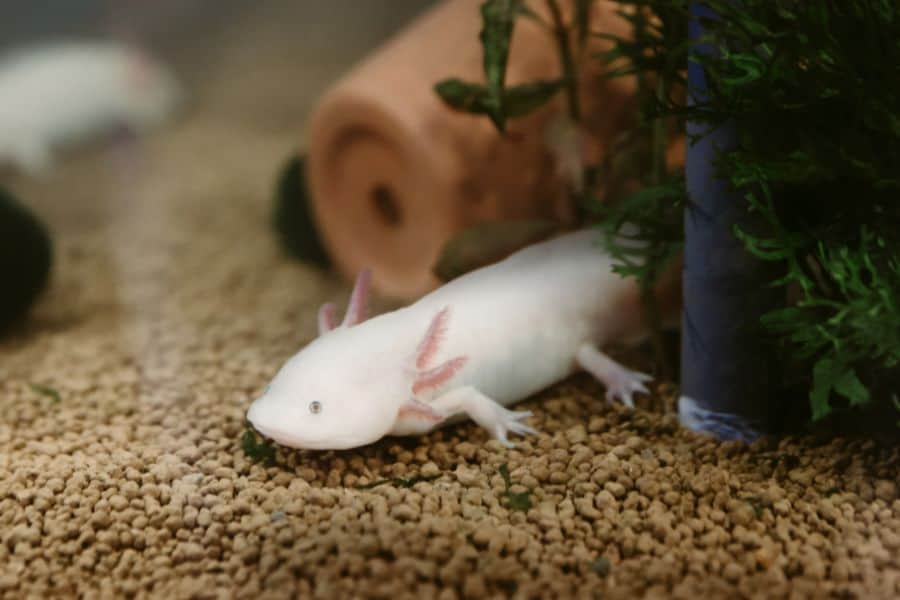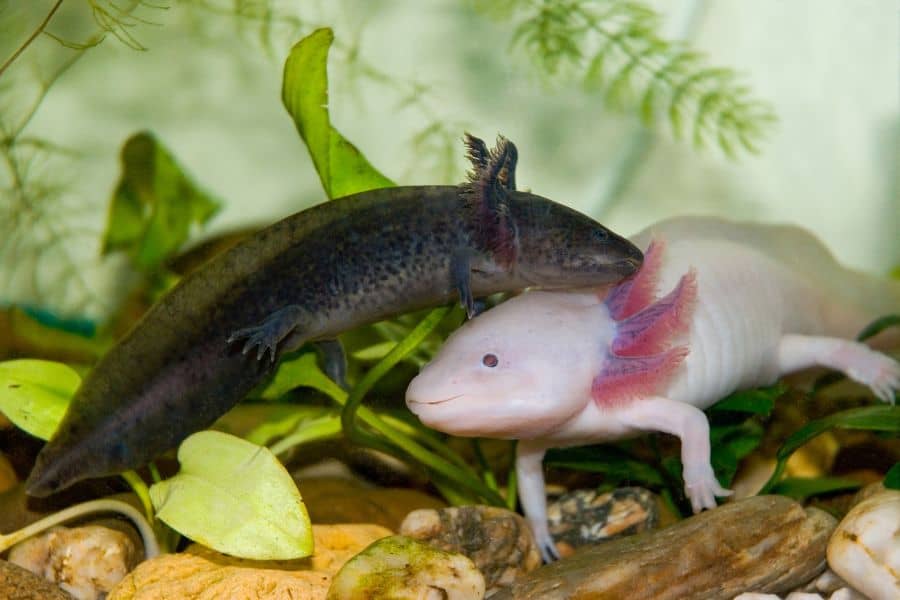Axolotls are some of the most fascinating pets that you can own. From their dragon-like appearance to their mysterious behavior, there’s a lot to love about this gorgeous reptile. That said, there’s one question burning in many curious minds: can axolotls live on land?
The short answer is — no, they can’t. Unfortunately, axolotls have adapted to wildly different environments than their salamander cousins, so they can’t survive outside of the water for long.
But of course, there’s more to it than that. Axolotl anatomy and care are interesting subjects, especially if you plan to take care of them in the future.
If you want to get to know how this attention-grabbing pet works, read on!
Why Axolotls Can’t Go On Land: Explaining Axolotl Anatomy
Axolotls can’t live on land because their anatomy is suited for it.
This is because of a phenomenon called neoteny. Essentially, these cute critters are salamanders who never underwent the metamorphosis and are still in the larval stage.
In other words, axolotls are basically just salamanders who didn’t and will never grow up.
True to their name, salamander larvae are larval creatures, like frog tadpoles. Typically these salamanders will outgrow their larval phase and grow stronger legs, shed their gills, and then go on to live on land.
However, this isn’t the case for axolotls.
There are a few theories for why that is. The most popular one is related to their last remaining natural habitat, Lake Xochimilco — an ancient lake that has never dried up.
As the theory goes, axolotls evolved to be purely aquatic species because they never needed to trade their aquatic characteristics (gills and tadpole-like tails) for terrestrial ones (such as well-developed legs).
Can Axolotls Breate Air?
Given this, however, you may be wondering: can axolotls breathe out of the water?
Actually, they can. Axolotls still do have lungs, and they can be observed to surface from the water and take a few gulps of air from time to time. That said, they don’t take more than a few seconds before going back to the water.
As you can see, their anatomy is extremely fascinating. There’s a reason why they’re so popular — and it’s mostly because of their very interesting characteristics. However, the specifics of axolotl biology are best left to labs.
Still, unless you’re a scientist, you’re probably mostly interested in keeping your axolotl happy, healthy, and safe, which is exactly what we’ll discuss in the next section.
Axolotls Dos and Don’ts
Axolotls can be difficult reptiles to keep, so if you’re planning on ever taking care of one, then you need to know the specifics of their care — not just their anatomy.
In this section, let’s go over the major dos and don’ts of axolotl care.
Don’t Take Them out Of the Water
This already goes without saying, but axolotls should never be taken out of the water.
While their lizard-like appearance and ability to breathe surface air might confuse beginner keepers, you must never take axolotls out of the water. Axolotls are aquatic creatures and are not suited for terrestrial environments, and there are a lot of things that can go wrong if you do so.
For one, taking them out of the water can stress them and cause harm to their delicate skin and gills. Two, they also have a very delicate slime coat that can cause health issues if it gets too dry.
Do Keep Them in Clean Water
Axolotls are aquatic animals that breathe through their gills.
Due to this, clean water that follows their specific parameter requirements is essential for their health.
Additionally, they’re very sensitive to changes in the water and can easily get sick, so you need to keep a close eye on your axolotl tank.
If they want to surface out of the water from time to time, then let them. But never let them stay out of the water for extended periods.
Be sure to keep them in a stable environment with the right equipment and environment.
Don’t Hold Axolotls with Your Bare Hands
Although they can regenerate entire limbs, they still have very delicate physical bodies.
Their body is almost entirely made of cartilage rather than bone. This also extends to their skin, which can be damaged when handled by human hands.
Also, as mentioned above, their slime coat is far more delicate and prone to damage. This coat gives extra protection to the axolotl and keeps them from immediately drying up or being affected in the water.
When you hold an axolotl with your bare hands, not only are they in danger of being damaged structurally, but their slime coat will also be affected.
Even if your touch isn’t enough to give them a bruise or an injury, they can become more prone to wounds or illnesses if their slime coat gets damaged.
Do Use Soft Nets to Transport Them
If you ever need to handle or transport your axolotls in any way, make sure you use large, soft nets that won’t harm their bodies.
Additionally, this minimizes the stress that they can get from being transported to another place.
Don’t Use Strong Filters that Will Disturb the Water
Axolotls are sensitive to water currents, and strong filters can stress them and disrupt their natural behavior.
While they do need oxygen in the water and even subtle movement, excessive water flow can impact their ability to catch food and move comfortably. Remember, axolotls are fragile, slow-moving creatures adapted to quiet and still lakes.
In other words, strong river-like currents are not for them. If you can, avoid strong internal filters that will disrupt the water and potentially make swimming harder for this small, gentle creature.
Do Use Quiet External Canister Filters
When it comes to filters, choose one that won’t disturb the water too much.
Generally, this means quiet, external canister filters. This type of filter is a good choice for axolotl tanks because they provide effective filtration without creating strong water currents that might affect them.
Here are some of the best options on the market:
- 45 gallons – Fluval 207 Perfomance Canister Filter
- 55 gallons – Aqueon QuietFlow Canister Aquarium Filter
- 97 gallons – MarineLand Magnum Polishing Internal Canister Filter
You can also use spray bars or other types of water flow control. Ensure that your filtration setup provides effective clean-up without causing stress to the quiet residents of the tank.
Axolotl Care Basics
While we’re at it, this section will review some of the basics of axolotl care to inform you better of the requirements for taking care of this gentle water dweller.
Tank Setup
Creating a suitable habitat for your axolotl is vital for their well-being, as they can be very picky about their environment. Let’s discuss their tank needs one by one.
- Tank size: A spacious tank is necessary, with a minimum size of 20 gallons per axolotl. However, bigger is better when it comes to their living space.
- Substrate: Choose large substrates like gravel to prevent accidental ingestion, as axolotls are prone to sucking things into their mouths. Fine gravel might be ingested and result in complications.
- Decor and environment: Include various hiding spots such as caves, PVC pipes, or live plants. These hiding spots not only offer security but also add complexity to the tank, making it more engaging for your axolotl. Not to mention, it’ll look beautiful.
- Lighting: Unlike many other reptile species, axolotls don’t need any special lighting. They prefer low to dim lighting and prefer to avoid bright spots in the aquarium.
- Companions: Axolotl tanks should contain nothing but axolotls. This is because they are apex predators in their natural habitat, and anything you put in the aquarium with them will likely end up in their mouths. Juvenile axolotls can be housed together, but as they grow older, they tend to become aggressive towards each other.
Now that you know about tank setup, let’s look into other care basics.
Parameters
Maintaining proper water conditions is crucial for axolotl health. They don’t have scales to protect them from the environment, so they are directly affected by the water. More than that, reptiles’ body temperatures are directly affected by their environment.
So, keep the following water parameters in mind when taking care of your axolotl.
- Temperature: Keep the water temperature between 60-68°F (15-20°C).
- pH level: The pH level should range from 6.5 to 7.5, providing a slightly acidic to neutral environment.
- Ammonia, nitrites, and nitrates: Regular water testing is essential, with ammonia and nitrite levels kept at zero and nitrates below 20 ppm.
To keep the water in top condition, be sure to perform partial water changes every week to maintain water quality and freshness.
Diet
Providing your pet axolotl with the proper diet is essential for their health.
These lizards are purely carnivorous, and in the wild, they hunt for their food. Thus, offer a variety of live or frozen foods, including earthworms, bloodworms, brine shrimp, and small fish.
Feed them in moderation, around once or twice every day. If you can, directly control their feed intake with tongs or other apparatus near the top or mid levels of your aquarium.
This will help ensure that the size of the food is appropriate for their mouth and that they aren’t going to accidentally ingest small gravel or sand particles from the bottom of the tank.
Also Read: Baby Axolotl Care
FAQs
How Long Can Axolotls Be out Of Water?
At most, axolotls should be out in the water for a few minutes. While they can survive up to an hour above water because of their lungs, their slime coat can dry up or be damaged, and they will likely suffer injuries and be stressed.
What Do Axolotls Eat?
Axolotls are carnivorous, and in the wild, they indiscriminately eat anything they can fit into their mouths. In the aquarium, feed them carnivorous food like brine shrimp or worms from the shop.
Are Axolotls Good for Beginners?
While these gentle, quiet aquatic lizards can be hardy and fun to care for, they’re generally not recommended for beginner reptile owners. This is because they have specific care requirements and sensitive constitutions that beginner keepers might not keep up with.
Conclusion
Axolotls are interesting creatures that make for great pets — but only if you know how to care for them properly.
Now that you know not to take them out of the water and not handle them with your hands, you’re much more knowledgeable than the rest of the population.
And with the basic care guide that you’ve read on the way, you’re well on your way to being an effective axolotl keeper!

